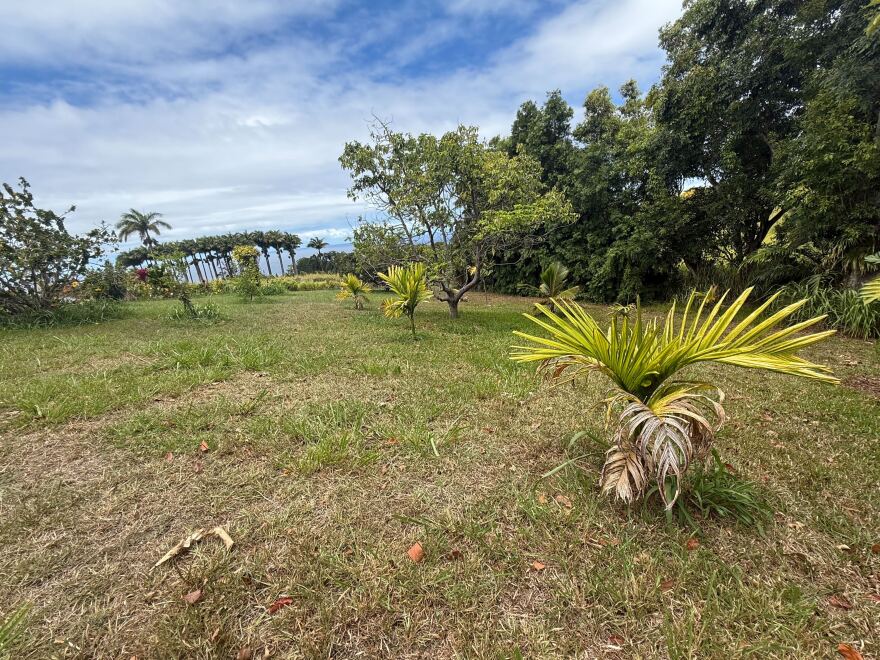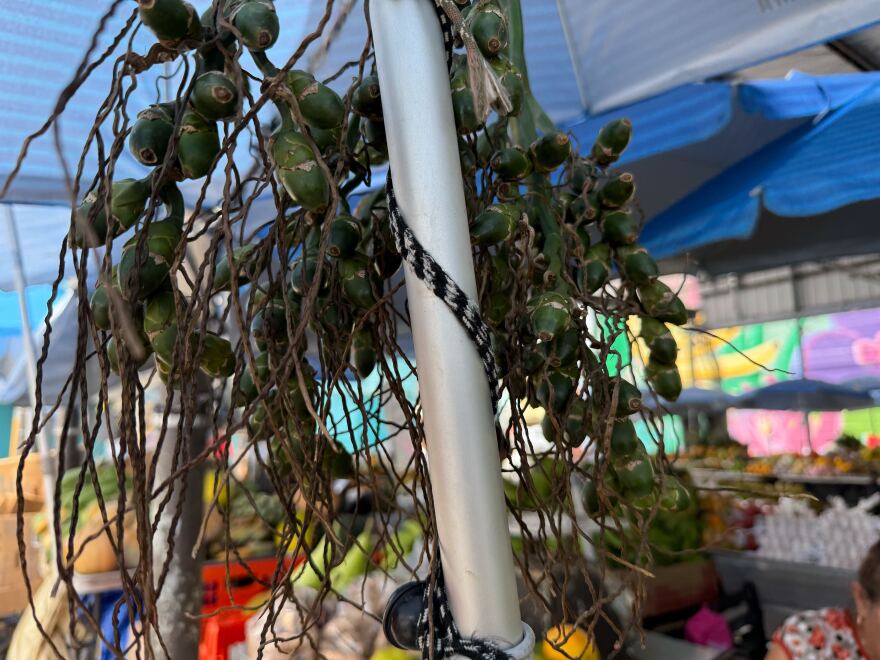At a small farmers market in downtown Hilo, several tables display rows of betel nut that hang from a line, attached to their original branches, or contained in sealed plastic bags.
On Hawaiʻi Island, there is no shortage of buyers for the tropical nuts. Chewing the seeds is a stimulant and used as a daily ritual by immigrant communities.
Farmers and sellers on the Big Island say there’s a higher demand for betel nut, but health experts warn about the consequences, as frequent chewing is linked to certain cancers.
The consumption of betel nut started as a ceremonial practice, but after the introduction of tobacco by the Spaniards, it has been used as a recreational activity.
More than 600 million people worldwide chew betel nut, including people in Southeast Asia, Micronesia and Melanesia. The practice continues to migrate in the Pacific and has even reached Hawaiʻi.
Selling betel nut is one option for Jermy Uowolo to make fast cash.
“I can make $100 to over $200 off one tree when they’re ready,” he said. “If you know the harvesting process and how to cultivate it, you can make good money.”
His 3-acre property is located about 25 miles north of downtown Hilo. He hasn’t been selling betel nut since he moved to his new house during the 2020 COVID-19 pandemic. He’s waiting for his latest crop of over 100 areca palms in his new yard to sprout betel nut. That could take five to 10 years after planting.

At his old property, Uowolo said he would sell 10,000 betel nuts a year. One tree can even produce more than 500 betel quids. If a farmer does it right, Uowolo said the tree can produce three generations of betel nut.
The tropical nut is a cultural practice in Micronesia, especially in the Republic of Palau, the Northern Mariana Islands and Yap, an island state in the Federated States of Micronesia.
Betel nut, also known as the areca nut, is a stimulant that can be chewed with slaked lime while wrapped in a pepper leaf. People also chew it with tobacco or dip it in whiskey.
In Palau and Yap, betel nut was a luxury reserved for high-ranking chiefs. After the introduction of tobacco, chewing became widespread, and people generally chew to feel invigorated.
Uowolo said that chewing betel nut is used for weddings, funerals, and even impressing a girl. It’s a cultural norm to pass around a basket full of betel nut in parts of Micronesia. The inside joke in the community is that “betel nut is the first thing you put in your mouth and the last thing you put in your mouth.”
“When you first meet someone, you don’t offer them food, you offer them betel nut,” he said.
It’s currently the dry season for betel nut on the Big Island, so the prices have risen. October and November are when there’s a greater abundance of betel nut, and sellers might reduce the price.

Uowolo isn’t the only one who grows betel nut. He said there are more than a dozen farmers that he knows who grow areca palm. Some are of Yapese, Vietnamese, and Filipino descent. Most of the sellers at the downtown Hilo farmers market are Filipino.
There are no laws that prohibit growing betel nut in Hawaiʻi that the state Department of Agriculture and Biosecurity enforces, according to spokesperson Janelle Saneishi.
“There are some restrictions on the import of betel nut for propagation, " Saneishi said in an email.
Health concerns
It’s unclear how many people chew betel nut in Hawaiʻi.
The U.S. Census Bureau reported that about 25,000 Micronesians live in Hawaiʻi. Of that population, about 10% to 15% – 2,500 to 3,750 – chew betel nut, according to a study by the University of Hawaiʻi at Manoa College of Education.
But chewing betel nut is not limited to Micronesians. Several immigrant communities in Hawaiʻi chew betel nut for cultural and social reasons, including people from the Solomon Islands and Papua New Guinea.
But studies have shown that Micronesians in Hawaiʻi and U.S.-affiliated Pacific Islands have higher rates of oral cancer than other ethnic groups due to chronically chewing betel nut.
Neal Palafox, a professor at the University of Hawaiʻi John A. Burns School of Medicine, explains that there are several components to why chewing betel nut – alone or with tobacco – is addictive.
“It increases your heart rate, it makes you flush, and it has a psychoactive substance in it,” he said. “It stimulates the area similar to nicotine in the brain that cigarettes do. It makes you have a little bit of a feeling of elation, but it’s short-lived.”

The arecoline in betel nut is one of the main substances from chewing betel nut, which is a class one carcinogen, according to Palafox, who said it causes cancer.
“It’s dose related,” he said. “It’s similar to if you smoke a cigarette once, you’re not going to get lung cancer.”
The number of betel nut chewers has increased in Micronesia as betel nut has been known to be in Palau, the Northern Mariana Islands, and Yap. Now, chewing betel nut has spread to Chuuk, Pohnpei and the Republic of the Marshall Islands.
“They never culturally chewed. It’s moving,” Palafox said. “Everybody says all Micronesian cultures chew. That’s not true.”
Part of Micronesia has implemented restrictions on the import of betel nut, especially for minors.
The Commonwealth of the Northern Mariana Islands banned the sale of betel nut to people under 18 in 2016, according to The Guam Daily Post. The CNMI also put warning labels on betel nut packages similar to the labels on chewing tobacco.
It is legal to chew betel nut in Hawaiʻi, although there are laws on spitting and using tobacco products in state parks. Some laws prohibit selling tobacco products and electronic smoking devices to minors, but no specific law for betel nut, as it is sold separately from tobacco.
“Within several immigrant communities in Hawaiʻi, betel quid holds cultural and social significance,” said Kristen Wong, a spokesperson at the state Department of Health. “This rooted social acceptance can make prevention and cessation efforts more complex.”
“The Hawaiʻi State Department of Health Tobacco Prevention and Control Section (DOH TPC) encourages collaborative engagement with community leaders to ensure that any public health messaging is both respectful and effective,” Wong continued. “Culturally grounded education remains essential for raising awareness about health harms while reducing initiation, especially among youth.”
Chronic betel nut chewing can lead to oral and throat cancers – something that concerns health experts.
Christopher Klem, an oral surgeon at The Queen’s Medical Center, said for the past 20 years, people from parts of Micronesia have been coming to his office seeking treatment for oral cancer that’s associated with chewing betel nut.
“Primarily, we’re talking about cancer inside of the cheek, the lip or the tongue," he said. “These can affect the jawbone, swallowing and eating. Oral cancer, like many cancers, the earlier that it’s detected, the better the outcomes are.”
He said it might be hard to implement state restrictions on betel nut due to its cultural significance and the abundance of the areca palm in the state. However, he emphasized the need for increased education about the overconsumption of betel nut.
‘It’s not a clean habit’
Jermy Uowolo hasn’t chewed betel nut in over 10 years. He said he primarily quit because he didn’t want to lose money by chewing his own products that he was growing in his yard, and he followed the advice of his dentist.
“It’s not a clean habit,” he said, adding that quitting was a personal choice.
Raymond Deleon Guerrero said he’s been trying to quit for several years.

Deleon Guerrero, who is both Chamorro and Palauan, said he likes to tell people that he has been chewing betel nut since he was 5 years old. But it was without tobacco, and it was used to help his aching teeth.
He said he didn’t start chewing betel nut with tobacco until he was in middle school.
“Culturally, whether it was peer pressure or everybody else was doing it, we’re seeing all the elders doing it,” Deleon Guerrero said. “We just picked up the habit.”
There are preferences for chewing betel nut. Some people chew without tobacco. Others chew with cigarettes or chewing tobacco.
Deleon Guerrero likes to add chewing tobacco because it has a sweeter taste. He said he likes to be discreet about his chewing and spitting because his mother taught him to be mindful.
“It’s funny because you asked me if I’m an avid chewer because I’m chewing right now,” he said.
Deleon Guerrero has tried to quit – both outright and gradually – for several years, but he said he’s “hooked on nicotine.”
“If I tried to quit chewing, I would start smoking. Doesn't help. I'm still consuming the nicotine,” he said. “I quit multiple times and lasted a couple of years. Then, through social events, seeing family coming to Hawaiʻi, I would start chewing again, and it became normal.”
Hawaiʻi Public Radio exists to serve all of Hawai’i, and it’s the people of Hawai’i who keep us independent and strong. Help keep us strong to serve you in the future. Donate today.





